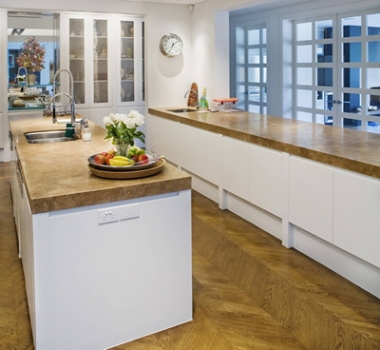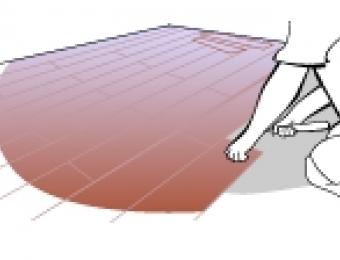How are kitchen floors used?
The kitchen is a very busy place in most homes; not only is it an area for cooking and preparing meals, but it can also be an ad hoc dining room. Many busy hours are spent standing on this floor in front of benches and sinks, and spills are very common. Dinner parties have a natural tendency to gravitate towards the kitchen too, so if you like to entertain guests, it's a good idea to have a floor that looks appealing too.

What to look for in a kitchen floor
Because kitchen floors see a lot of use and abuse, you should choose one that satisfies the following criteria:
- Easy to clean and maintain
- Comfortable to stand on for long periods
- Durable and hard wearing, resistant to scratching
Ease of maintenance is usually the biggest factor when considering what to put down in the kitchen. Because the kitchen's a food preparation area, you won’t want anything that can’t be made hygienic with a quick sweep and mop. Ideally, the surface will be completely waterproof and flat make it easy to clean spills and splashes. Carpet, for example, is a poor choice in the kitchen, while lino, tiles, floorboards and floating floor fit the bill nicely.
A factor that not many people consider is the long term effects of spending hours each day standing on a very hard surface. Over time, this can be damaging to the hips, knees and ankles, so any give or bounce in the floor can help ease the strain on joints. A polished concrete or stone floor isn't necessarily a bad idea in the kitchen - but if you do spent lots of time there, you may want to consider putting a rubber mat down where you stand most, to reduce the strain on your joints.
The floor surface you choose should also be hard wearing; there will be a lot of traffic over this floor and it is usually one of the first places in the house to show signs of wear and tear.
Other factors
The floor should be aesthetically pleasing as it will enhance the appeal of the whole kitchen. State of the art cookware, expensive countertops and elaborate cabinetry will all be let down with the wrong choice of floor. The kitchen is typically a well-lit area and often incorporates natural light, so fade resistance can be beneficial. It should also offer good traction to avoid falls, especially when wet.
What sorts of floors are commonly used in kitchens?
There are a number of surfaces commonly used in the kitchen, but the most popular are vinyl and linoleum. Both are super easy to clean, comfortable underfoot, resistant to spills and come in a huge variety of different styles to suit any décor. Another factor contributing to their popularity is how cheap they are to buy. While vinyl and linoleum both fit the bill perfectly on most other counts, they aren't especially durable, and can show up scratches and scuff marks easily. Vinyl is also easily burned, something that is usually only of concern in a kitchen.
There are many other options that are suitable for kitchen floors. These include tiles, floorboards, floating floor and stone, all of which fulfil the practical criteria listed above, and all of which offer very different things in terms of the way they look and feel.





